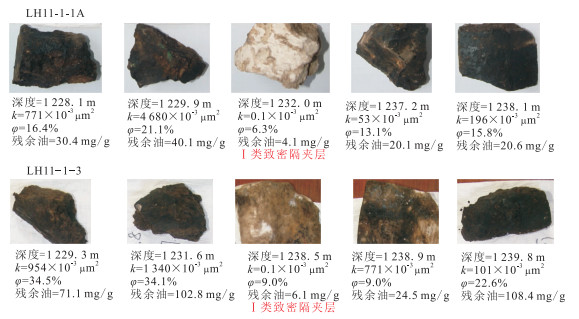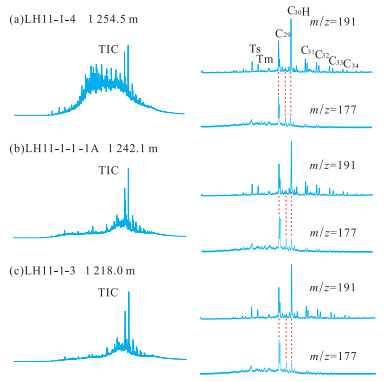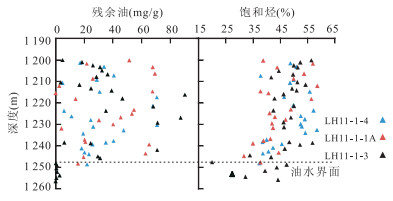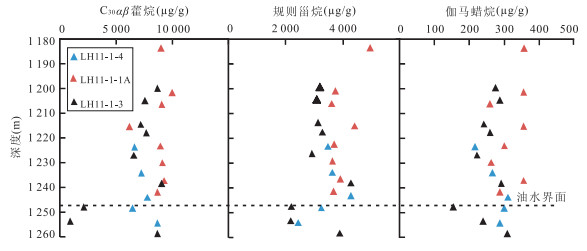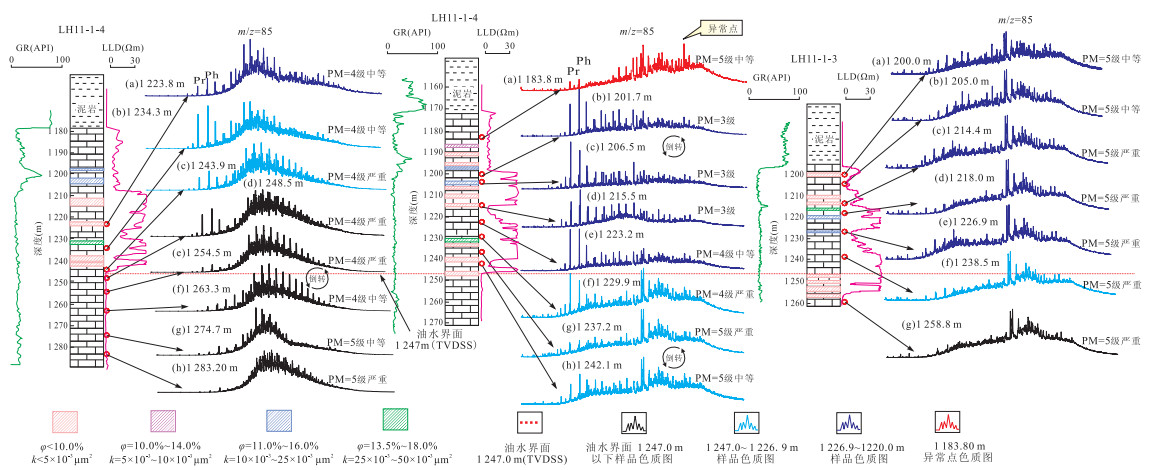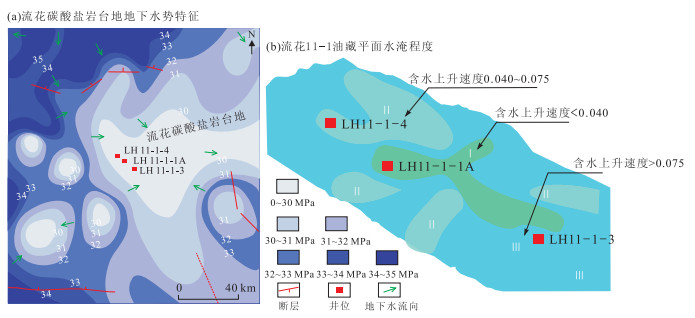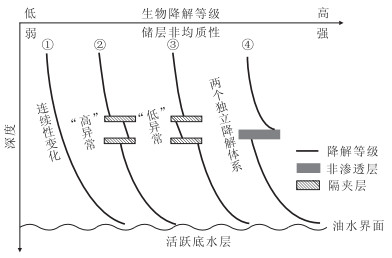Control Effects of Petroleum Biodegradation Degree by Bottom Water and Intercalation within Oil Reservoir
-
摘要: 系统剖析流花11-1礁灰岩油藏储层烃类的生物降解特征, 揭示油藏底水与隔夹层对原油生物降解程度具有显著控制效应, 这使得油藏原油生物降解程度及其分布预测更加复杂化.研究发现, 流花11-1油藏具有统一的油水界面, 油源类型单一, 原油成熟度较高且分布较窄, 可能为短期快速充注所形成的油藏.原油普遍遭受生物降解, 降解程度均小于6级.垂向上, 隔夹层虽可引起局部储层烃类降解程度的倒转, 但单井油柱生物降解等级仍以储层与油水界面的距离为主要控制因素, 表现为降解程度由顶部向底部呈明显梯度变化, 油藏底水控制效应明显.横向上, 油藏降解程度的差异主要由隔夹层控制下储层内原油与活跃底水的接触程度不同导致.在隔夹层密集发育区流体运动受阻, 进而使微生物营养物质供应不足, 代谢物质交换不畅, 原油降解程度相对较低.在上述研究的基础上, 建立了油藏底水与储层非均质性对原油生物降解程度的控制效应模型, 并探讨了该方法在稠油油藏开发中的应用.Abstract: The research of the controls on the degrees of petroleum biodegradation within heavy oil reservoirs will benefit heavy oil reservoirs developing optimization and enhancing recovery efficiency.The characteristics of biodegradation of the saturated hydrocarbon for core extracts from the Liuhua11-1 reef reservoir are analyzed in this study, and the results show that bottom water and intercalation within the oil reservoir can significantly control the degree of petroleum biodegradation and affect the prediction of oil physical property. Liuhua11-1 reservoir has the one oil-water contact (OWC), with the hydrocarbon generated from the same source rock at similar high maturity and suffered from biodegradation less than level 6. Although the intercalations may lead to the occurrence of inversion of biodegradation level of oil columns, biodegradation level is mainly controlled by the vertical distance from its in situ place to OWC, which is characterized by the biodegradation degree increasing from the top of oil columns to the bottom with excellent gradient variations. Laterally, the biodegradation level varies significantly within the reservoir. It is mainly dominated by the extent of oil-water-contact area controlled by intercalations. And intercalations also lead to the insufficient supply of nutrients and poor metabolism exchange because the fluid flow can hardly pass in the area where intercalations develop, which results in lower biodegradation. A model of control effects of petroleum biodegradation degree by bottom water and reservoir heterogeneity within the oil reservoir is established, and its application in heavy oil reservoir development is discussed in this paper.
-
图 1 珠江口盆地构造区划及流花11-1油藏剖面
据岳大力等, 2005a, 2005b修改
Fig. 1. Structure framework of Pearl River Mouth basin and the cross-section of Liuhua11-1 reservoir
表 1 流花11-1油藏岩心抽提物饱和烃生物标志化合物参数
Table 1. Biomarker parameters of saturated hydrocarbons for core extracts from the Liuhua11-1 reservoir
井号 深度(m) 生物标志化合物参数 1 2 3 4 5 6 7 8 9 LH11-1-4 1 223.8 0.50 0.49 0.58 1.26 0.94 0.15 0.03 0.45 0.37 LH11-1-4 1 234.3 0.52 0.48 0.59 1.25 1.01 0.16 0.04 0.44 0.39 LH11-1-4 1 243.9 0.52 0.48 0.58 1.24 0.78 0.15 0.04 0.45 0.37 LH11-1-4 1 248.5 0.53 0.47 0.58 1.26 0.97 0.15 0.05 0.45 0.39 LH11-1-4 1 254.5 0.52 0.47 0.60 1.42 0.75 0.14 0.06 0.48 0.34 LH11-1-4 1 263.3 0.54 0.46 0.60 1.37 0.86 0.14 0.05 0.46 0.37 LH11-1-4 1 274.7 0.54 0.48 0.59 1.18 0.72 0.15 0.04 0.50 0.33 LH11-1-4 1 283.2 0.50 0.49 0.58 1.38 0.87 0.14 0.04 0.45 0.35 LH11-1-1A 1 183.8 0.56 0.49 0.59 1.35 0.99 0.19 0.04 0.43 0.54 LH11-1-1A 1 201.7 0.52 0.48 0.58 1.30 1.12 0.15 0.04 0.40 0.40 LH11-1-1A 1 206.5 0.54 0.47 0.58 1.25 1.05 0.14 0.03 0.42 0.36 LH11-1-1A 1 215.5 0.61 0.39 0.58 1.29 0.60 0.15 0.06 0.48 0.38 LH11-1-1A 1 223.2 0.60 0.45 0.58 1.24 1.05 0.15 0.03 0.42 0.40 LH11-1-1A 1 229.9 0.54 0.47 0.58 1.28 1.06 0.15 0.03 0.42 0.38 LH11-1-1A 1 237.2 0.52 0.48 0.58 0.99 1.07 0.15 0.04 0.41 0.39 LH11-1-1A 1 242.1 0.52 0.48 0.58 1.25 1.07 0.16 0.03 0.40 0.40 LH11-1-3 1 200.0 0.55 0.47 0.58 1.38 1.00 0.16 0.03 0.41 0.41 LH11-1-3 1 205.0 0.53 0.49 0.59 1.39 0.99 0.15 0.03 0.41 0.40 LH11-1-3 1 214.4 0.53 0.50 0.58 1.36 1.02 0.15 0.03 0.42 0.40 LH11-1-3 1 218.0 0.52 0.50 0.58 1.39 1.04 0.15 0.03 0.43 0.43 LH11-1-3 1 226.9 0.53 0.49 0.58 1.36 1.01 0.14 0.03 0.42 0.41 LH11-1-3 1 238.5 0.61 0.44 0.57 1.38 0.78 0.15 0.03 0.42 0.41 LH11-1-3 1 258.8 0.55 0.49 0.57 1.35 0.96 0.15 0.04 0.42 0.42 平均值 - 0.54 0.47 0.58 1.30 0.94 0.15 0.04 0.44 0.39 注:1.C29甾烷ααα20S/(20S+20R);2.C29甾烷ββ/(αα+ββ);3.C31升藿烷22S/(22S+22R);4.Ts/Tm;5.C30 4-甲基甾烷/C29规则甾烷;6.奥利烷/C30藿烷;7.伽马蜡烷/C30藿烷;8.(C28三环萜烷+C29三环萜烷)/(C28三环萜烷+C29三环萜烷+Ts);9.T/ C30藿烷.Ts.三降新藿烷;Tm.三降藿烷;T.C30双杜松烷. -
Bennett, B., Adams, J.J., Gray, N.D., et al., 2013. The Controls on the Composition of Biodegraded Oils in the Deep Subsurface—Part 3. The Impact of Microorganism Distribution on Petroleum Geochemical Gradients in Biodegraded Petroleum Reservoirs. Organic Geochemistry, 56: 94-105. doi: 10.1016/j.orggeochem.2012.12.011 Brooks, P.W., Fowler, M.G., Macqueen, R.W., 1988. Biological Marker and Conventional Organic Geochemistry of Oil Sands/Heavy Oils, Western Canada Basin. Organic Geochemistry, 12(6): 519-538. doi: 10.1016/0146-6380(88)90144-1 Chen, D.X., Wu, S.G., Shi, H.S., et al., 2012. Seismic Characteristics and Generations of Sinkholes in the Liuhua Carbonate Platform, Pearl River Mouth Basin. Journal of Jilin University (Earth Science Edition), 42(6): 1935-1943 (in Chinese with English abstract). http://www.researchgate.net/publication/286164951_Seismic_characteristics_and_generations_of_sinkholes_in_the_Liuhua_carbonate_platform_Pearl_River_Mouth_basin Fredrickson, J.K., McKinley, J.P., Bjornstad, B.N., et al., 1997. Pore-Size Constraints on the Activity and Survival of Subsurface Bacterial in a Late Cretaceous Shale-Sandstones Sequence, Northwestern New Mexico. Geomicrobiology Journal, 14(3): 183-202. doi: 10.1080/01490459709378043 Gates, I.D., Adams, J., Larter, S.R., 2008. The Impact of Oil Viscosity Heterogeneity on the Production Characteristics of Tar Sand and Heavy Oil Reservoirs. Part Ⅱ: Intelligent, Geotailored Recovery Processes in Compositionally Graded Reservoirs. Journal of Canadian Petroleum Technology, 47(9): 40-49. doi: 10.2118/08-01-52 Gong, L., Zhu, H.T., Shu, Y., et al., 2014. Distribution of Middle-Deep Lacustrine Source Rocks within Sequence Stratigraphic Framework of Wenchang Formation in Enping Depression, the Pearl River Mouth Basin. Earth Science—Journal of China University of Geosciences, 39(5): 546-556 (in Chinese with English abstract). http://en.cnki.com.cn/Article_en/CJFDTOTAL-DQKX201405005.htm Gu, L., Hu, G.Y., Luo, W.S., et al., 2012. Characteristics and Genesis of Reservoir Spaces in Neocene Reef Reservoir of Liuhua Oilfield, Pearl River Mouth Basin. Earth Science Frontiers, 19(2): 49-58 (in Chinese with English abstract). http://d.wanfangdata.com.cn/Periodical/dxqy201202008 Head, I.M., Jones, D.M., Larter, S.R., 2003. Biological Activity in the Deep Subsurface and the Origin of Heavy Oil. Nature, 426(6964): 344-352. doi: 10.1038/nature02134 Henry, L.E., Dianne, K.N., 2008. Geomicrobiology. Fifth Edition. CRC Press, Boca Raton. Huang, H.P., Gates, I., Larter, S., 2010. Application of Fluid Heterogeneity in Heavy Oil Reservoir Appraisal and Production. Sino-Global Energy, 15(10): 34-42 (in Chinese with English abstract). http://www.cqvip.com/QK/88503X/201010/35405236.html Huang, H.P., Larter, S., 2010. The Origin of Heterogeneity and Prediction of Physical Property of the Fluid within Heavy Oil Reservoirs. Sino-Global Energy, 15(9): 43-51 (in Chinese with English abstract). http://search.cnki.net/down/default.aspx?filename=SYZW201009011&dbcode=CJFD&year=2010&dflag=pdfdown Huang, H.P., Larter, S.R., Bowler, B.F.J., et al., 2004. A Dynamic Biodegradation Model Suggested by Petroleum Compositional Gradients within Reservoir Columns from the Liaohe Basin, NE China. Organic Geochemistry, 35(3): 299-316. doi: 10.1016/j.orggeochem.2003.11.003 Jones, D.M., Head, I.M., Gray, N.D., et al., 2007. Crude-Oil Biodegradation via Methanogenesis in Subsurface Petroleum Reservoirs. Nature, 451(7175): 176-180. http://www.nature.com/articles/nature06484/ Krumholz, L.R., 2000. Microbial Communities in the Deep Subsurface. Hydrogeology Journal, 8(1): 4-10. doi: 10.1007/s100400050003 Larter, S.R., Adams, J.J., Gates, I.D., et al., 2008. The Origin, Prediction and Impact of Oil Viscosity Heterogeneity on the Production Characteristics of Tar Sand and Heavy Oil Reservoirs. Journal of Canadian Petroleum Technology, 47(1): 52-61. doi: 10.2118/08-01-52 Larter, S.R., Huang, H.P., Adams, J., 2012. A Practical Biodegradation Scale for Use in Reservoir Geochemical Studies of Biodegraded Oils. Organic Geochemistry, 45: 66-76. doi: 10.1016/j.orggeochem.2012.01.007 Larter, S.R., Huang, H.P., Adams, J., et al., 2006. The Controls on the Composition of Biodegraded Oils in the Deep Subsurface: Part Ⅱ—Geological Controls on Subsurface Biodegradation Fluxes and Constraints on Reservoir-Fluid Property Prediction. AAPG Bulletin, 90(6): 921-938. doi: 10.1306/01270605130 Larter, S.R., Primio, R.D., 2005. Effects of Biodegradation on Oil and Gas Field PVT Properties and the Origin of Oil Rimmed Gas Accumulations. Organic Geochemistry, 36(2): 299-310. doi: 10.1016/j.orggeochem.2004.07.015 Larter, S.R., Wilhelms, A., Head, I., et al., 2003. The Controls on the Composition of Biodegraded Oils in the Deep Subsurface—Part Ⅰ: Biodegradation Rates in Petroleum Reservoirs. Organic Geochemistry, 34(4): 601-613. doi: 10.1016/S0146-6380(02)00240-1 Li, S.F., Xu, S.H., Shi, H.S., et al., 2013. Characteristics of Paleogene Source Rocks and Prediction of Petroleum Resources in Huizhou Depression, Pearl River Mouth Basin. Earth Science—Journal of China University of Geosciences, 38(1): 112-120 (in Chinese with English abstract). doi: 10.3799/dqkx.2013.011 Li, Y.C., Tao, W.X., Sun, Y.M., et al., 2009. Classification and Distribution of Oil in Huizhou Depression of Pearl River Mouth Basin. Acta Petrolei Sinica, 30(6): 830-834, 842 (in Chinese with English abstract). http://www.researchgate.net/publication/283878974_Classification_and_distribution_of_oil_in_Huizhou_Depression_of_Pearl_River_Mouth_Basin?_sg=9hXlnv6sqn-lKvur9QPgTnVdVxZrtKQGvpuyzvjAIJiHV5UEcIBpPfKhAxqW2BAMEPzxr1EvWVl-jO42_it-YA Peters, K.E., Moldowan, J.M., 1993. The Biomarker Guide: Interpreting Molecular Fossils in Petroleum and Ancient Sediments. Englewood Cliffs, NJ, Prentice Hall. Peters, K.E., Walters, C.C., Moldowan, J.M., 2005. The Biomarker Guide: Biomarkers and Isotopes in the Environment and Human History, Vol. 1. Cambridge University Press, Cambridge. Seifert, W.K., Moldowan, J.M., 1986. Use of Biological Markers in Petroleum Exploration. Elsevier, Amsterdam, 261-290. Shi, H.S., Yun, J.B., Qiu, H.N., 2011. Dating Petroleum Emplacement by Illite 40Ar/39Ar Laser Stepwise Heating: Reply. AAPG Bulletin, 95(12): 2112-2116. doi: 10.1306/03241110163 Tyrrell, W.W., Christian, H.E., 1992. Exploration History of the Liuhua 11-1 Field, Pearl River Mouth Basin, China. AAPG Bulletin, 76(8): 1209-1223. http://aapgbull.geoscienceworld.org/content/76/8/1209 Wenger, L.M., Davis, C.L., Isaksen, G.H., 2002. Multiple Controls on Petroleum Biodegradation and Impact on Oil Quality. SPE Reservoir Evaluation & Engineering, 5(5): 375-383. http://www.researchgate.net/publication/250089647_Multiple_Controls_on_Petroleum_Biodegradation_and_Impact_on_Oil_Quality Wang, C.M., Li, D.P., Liu, S.G., 2007. Effects of Biophysiological and Biochemical Characteristics of a Strain of Microbacterium sp. on Properties of Thickened Oil. Acta Petrolei Sinica, 28(5): 89-92 (in Chinese with English abstract). http://www.cnki.com.cn/Article/CJFDTotal-SYXB200705017.htm Wu, X.C., Wang, Q. F, . Li, P.H., et al., 2010. Chalky Texture Formation and Chalky Porous Reservoir of Liuhua Reef-Bank Complex on the Early Miocene Dongsha Platform, South China Sea. Journal of Palaeogeography, 12(4): 451-466 (in Chinese with English abstract). http://www.cqvip.com/QK/84020X/20104/34783048.html Yao, B.C., Wan, L., Liu, Z.H., 2004. Tectonic Dynamics of Cenozoic Sedimentary Basins and Hydrocarbon Resources in the South China Sea. Earth Science—Journal of China University of Geosciences, 29(5): 543-549 (in Chinese with English abstract). http://en.cnki.com.cn/Article_en/CJFDTOTAL-DQKX200405006.htm Yue, D.L., Wu, S.H., Lin, C.Y., et al., 2005a. Remaining Oil Distribution Controlled by Intercalation in Reef Limestone Reservoir. Petroleum Exploration and Development, 32(5): 113-117 (in Chinese with English abstract). Yue, D.L., Wu, S.H., Lin, C.Y., et al., 2005b. Reservoir Heterogeneity and Remaining Oil Distribution Pattern of Reef Limestone Reservoir in Liuhua 11-1 Oilfield. Geological Science and Technology Information, 24(2): 90-96 (in Chinese with English abstract). http://en.cnki.com.cn/Article_en/CJFDTOTAL-DZKQ200502020.htm Zhang, S.C., Gong, Z.S., Liang, D.G., et al., 2004. Geochemistry of Petroleum Systems in the Eastern Pearl River Mouth Basin—Ⅰ: Oil Family Classification, Oil-Source Correlation and Mixed Oil Analysis. Acta Sedimentologica Sinica, 22(Suppl. ): 15-26 (in Chinese with English abstract). http://www.cqvip.com/qk/95994X/2004B06/10017114.html Zhao, H.T., Wu, S.G., Ma, Y.B., et al., 2012. An Evolutionary Model of Bio-Reefs at the Dongsha Uplift, Zhujiangkou Basin, South China Sea. Marine Geology & Quaternary Geology, 32(1): 43-50 (in Chinese with English abstract). http://www.researchgate.net/publication/273679422_AN_EVOLUTIONARY_MODEL_OF_BIO-REEFS_AT_THE_DONGSHA_UPLIFT_ZHUJIANGKOU_BASIN_SOUTH_CHINA_SEA/download Zhao, H.J., Zhang, C.M., Mei, B.W., et al., 2004. Prediction of Difficulty for Developing Heavy Oil Reservoir with Geochemical Parameters. Acta Petrolei Sinica, 25(3): 61-65 (in Chinese with English abstract). http://www.researchgate.net/publication/298187163_Prediction_of_difficulty_for_developing_heavy_oil_reservoir_with_geochemical_parameters Zhu, J.Z., Shi, H.S., Deng, H.W., et al., 2007. Geochemistry of Source Rocks in Paleogenge Sequence of Huizhou Depression, Pearl River Mouth Basin. Natural Gas Geoscience, 18(5): 709-714 (in Chinese with English abstract). http://www.researchgate.net/publication/288936364_Geochemistry_of_source_rocks_in_Paleogene_sequence_of_Huizhou_depression_Pearl_River_Mouth_Basin 陈端新, 吴时国, 施和生, 等, 2012. 珠江口盆地流花碳酸盐台地灰岩坑的地震反射特征及成因探讨. 吉林大学学报(地球科学版) 42(6): 1935-1943. https://www.cnki.com.cn/Article/CJFDTOTAL-CCDZ201206042.htm 龚丽, 朱红涛, 舒誉, 等, 2014. 珠江口盆地恩平凹陷文昌组层序格架中中——深湖相烃源岩空间展布规律及发育模式. 地球科学——中国地质大学学报, 39(5): 546-556. https://www.cnki.com.cn/Article/CJFDTOTAL-DQKX201405005.htm 古莉, 胡光义, 罗文生, 等, 2012. 珠江口盆地流花油田新近系生物礁灰岩储层特征及成因分析. 地学前缘, 19(2): 49-58. https://www.cnki.com.cn/Article/CJFDTOTAL-DXQY201202009.htm 黄海平, Gates, I., Larter, S., 2010. 储层流体非均质性在重油评价及开发生产上的应用. 中外能源, 15(10): 34-42. https://www.cnki.com.cn/Article/CJFDTOTAL-SYZW201010012.htm 黄海平, Larter, S., 2010. 重油储层流体非均质性成因及流体物性预测. 中外能源, 15(9): 43-51. https://www.cnki.com.cn/Article/CJFDTOTAL-SYZW201009011.htm 李松峰, 徐思煌, 施和生, 等, 2013. 珠江口盆地惠州凹陷古近系烃源岩特征及资源预测. 地球科学——中国地质大学学报, 38(1): 112-120. https://www.cnki.com.cn/Article/CJFDTOTAL-DQKX201301015.htm 李友川, 陶维祥, 孙玉梅, 等, 2009. 珠江口盆地惠州凹陷及其邻区原油分类和分布特征. 石油学报, 30(6): 830-834, 842. https://www.cnki.com.cn/Article/CJFDTOTAL-SYXB200906007.htm 王春明, 李大平, 刘世贵, 2007. 稠油开采微生物的生理生化特征及其对原油特性的影响. 石油学报, 28(5): 89-92. https://www.cnki.com.cn/Article/CJFDTOTAL-SYXB200705017.htm 吴熙纯, 王权锋, 李培华, 等, 2010. 南海早中新世东沙台地流花生物礁—滩组合的白垩状结构化及白垩状孔隙储集层. 古地理学报, 12 (4): 451-466. https://www.cnki.com.cn/Article/CJFDTOTAL-GDLX201004011.htm 姚伯初, 万玲, 刘振湖, 2004. 南海海域新生代沉积盆地构造演化的动力学特征及其油气资源. 地球科学——中国地质大学学报, 29(5): 543-549. https://www.cnki.com.cn/Article/CJFDTOTAL-DQKX200405006.htm 岳大力, 吴胜和, 林承焰, 等, 2005a. 礁灰岩油藏隔夹层控制的剩余油分布规律研究. 石油勘探与开发, 32(5): 113-117. https://www.cnki.com.cn/Article/CJFDTOTAL-SKYK200505025.htm 岳大力, 吴胜和, 林承焰, 等, 2005b. 流花11-1油田礁灰岩油藏储层非均质性及剩余油分布规律. 地质科技情报, 24(2): 90-96. https://www.cnki.com.cn/Article/CJFDTOTAL-DZKQ200502020.htm 张水昌, 龚再升, 梁狄刚, 等, 2004. 珠江口盆地东部油气系统地球化学-Ⅰ: 油组划分、油源对比及混源油确定. 沉积学报, 22(增刊): 15-26. https://www.cnki.com.cn/Article/CJFDTOTAL-CJXB2004S1003.htm 赵撼霆, 吴时国, 马玉波, 等, 2012. 南海珠江口盆地东沙隆起区生物礁演化模式. 海洋地质与第四纪地质, 32(1): 43-50. https://www.cnki.com.cn/Article/CJFDTOTAL-HYDZ201201011.htm 赵红静, 张春明, 梅博文, 等, 2004. 利用地化参数预测稠油油藏开采难度. 石油学报, 25(3): 61-65. https://www.cnki.com.cn/Article/CJFDTOTAL-SYXB200403012.htm 朱俊章, 施和生, 邓宏文, 等, 2007. 珠江口盆地惠州凹陷古近系烃源岩层序地层学和地球化学研究. 天然气地球科学, 18(5): 709-714. https://www.cnki.com.cn/Article/CJFDTOTAL-TDKX200705016.htm -









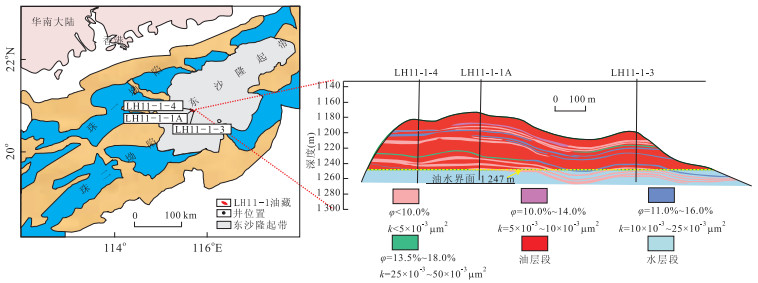
 下载:
下载:
